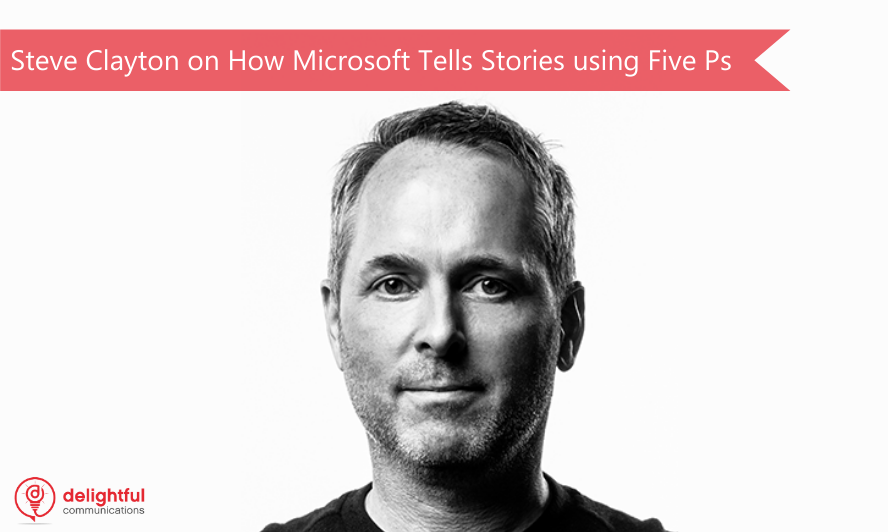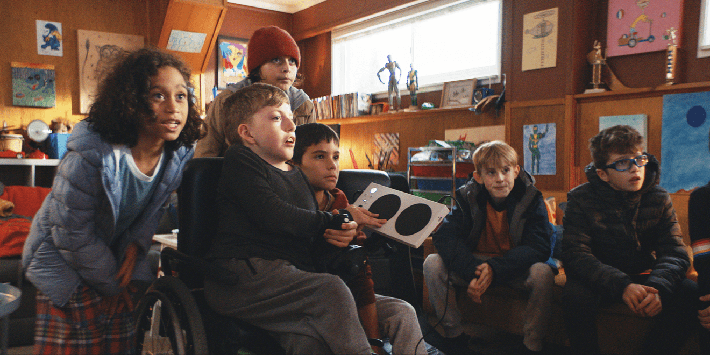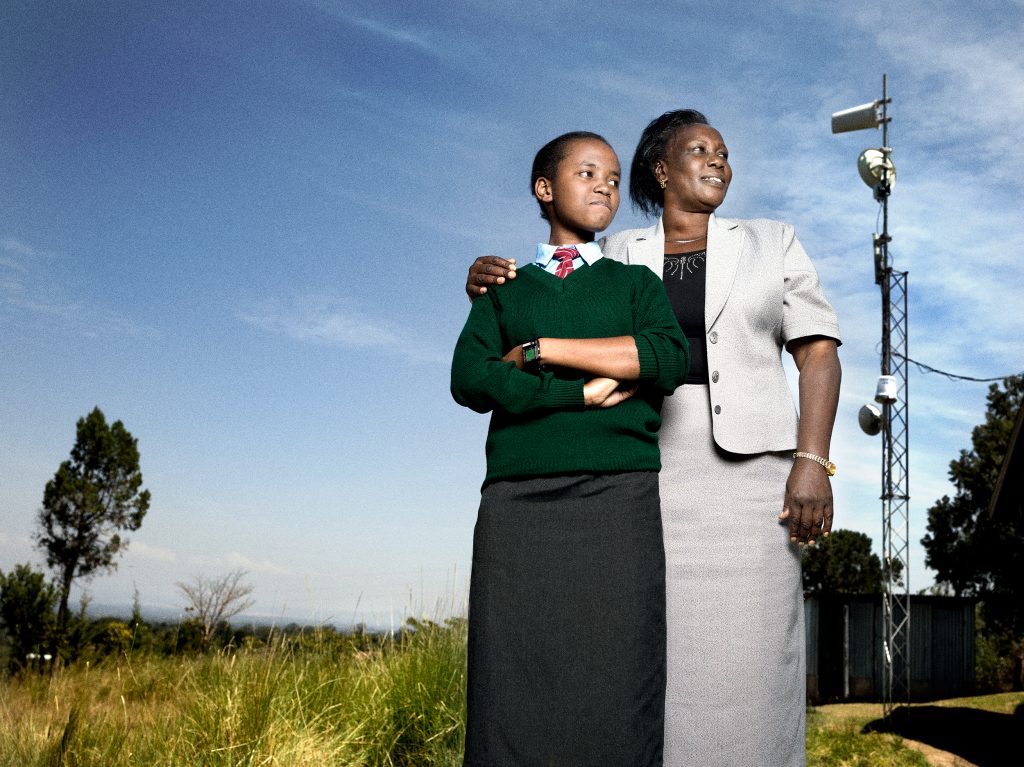
Smale, B. (Photographer). (2019.) Steve Clayton [digital image]. Retrieved from Steve Clayton.
Have you ever witnessed a commercial that hit home with you so intensely, or made you resonate so deeply, that you cried? At the Ragan PR and Social Media Summit in Redmond, there were few dry eyes in the house when Steve Clayton, Microsoft’s chief storyteller, told us about the Super Bowl-shaking moment when Microsoft released its Xbox Adaptive Controller commercial.
A long-time fan of Microsoft advertising and their Accessibility/Enable channels, I was thrilled to hear how the world-renowned technology giant came to become one of the most recognizable global brands. I can promise it didn’t disappoint.
Steve Clayton has been with Microsoft for 21 years and was accidentally hired. Thought to be another Steve (don’t worry, he was obviously the right fit for the role), he’s been storytelling for Microsoft ever since. His presentation covered, “Creating a culture of storytelling and innovation.”
Clayton offered us an inside look into Microsoft then, and now: how it recognized that it’s advertising ship was sinking, and how it healed its rupturing reputation by identifying past issues and updating to a new style of branding.
Working from scratch: redefining the values of the Microsoft brand
In a lot of ways, the release of the commercial for the Xbox Adaptive Controller signaled a transition at Microsoft. The company went from lampooning to reaping the rewards of a successful and authentic re-brand.

Microsoft. (Photograph). 2018. Reindeer Games [digital image]. Retrieved from https://www.adweek.com/agencies/a-young-gamer-gets-the-heros-treatment-in-this-endearing-ad-for-microsofts-adaptive-controller/
Clayton’s reasoning for why the commercial resonated so well? It wasn’t just in the unique imagery, but their strategic decision of approaching the commercial around a simple premise: hire talented people that are inspired to share the heartwarming, innovative story of the Adaptive Controller. What came next was a natural fit for the brand and technology. The commercial quickly became a reflection of where the company has come, and where it’s headed moving forward.
“Microsoft by the Numbers” and the story “88 acres,” are other prime examples of how the company was able to catch the eyes of tens of thousands of individuals with their campaigns. Starting as an uncomplicated idea, Microsoft published a story detailing the technology behind the 88 acres that their Redmond HQ lives, sits, and breathes on.
The story published off-the-radar, without any amplification from within the company. But by the time weekday hit on Monday morning, the story of “88 acres” was splashed across major news sites. Microsoft received correspondence from multiple corporations asking if they could purchase the technology, or some variation of the 88 acres, for their own corporate use. The answer was no, but audiences loved the story of “88 acres” so much, that “Microsoft by the Numbers” took on a similar role to include audiences in the revolutionary tech fueling the campus.
Turning over a new leaf: telling the story of Microsoft’s metamorphosis
Over time, Microsoft has broken down the topics of its company-wide “Culture Communications.” As they revamped and restructured what was important to them and how they wanted to be regarded, they came down to five topics for company-facing language: customer-obsessed, growth mindset, diversity and inclusion, making a difference, and One Microsoft.
From there, Clayton shares, the company began to experiment with different mediums as a way to surprise and delight their audiences. Not only was this practiced this externally, but internally, to signal to employees that times were changing. Microsoft was beginning to evolve into something better than it had ever been before.
Microsoft took one of the most commonly used items at their Redmond campus and gave it a story to tell: the recyclable coffee cup. Periodically, the company will run “Coffee Cup Campaigns,” where they highlight one of the five, aforementioned topics as quotes and illustrations to inspire employees and guests (see designer pages here and here). If you’re on their campus, you won’t go long without being reminded about Microsoft’s commitment to its core values.
In this discussion, Clayton expressed a formulaic way to tell the story of your brand or organization. Consider People, Place, Pictures, Platforms & Personal. Using these elements allows you to reconnect your brand with its values and help showcase them in an authentic and mindful way.
Who are the People behind your story? They should always play a part.
There should always be people and their stories and personalities in your campaigns. Cue the moment when Clayton pulled up the moving video for “Project Emma” (this is where half the room began to wipe their eyes and sniffle). The emotional video tells the story of Emma, who is living with Parkinson’s. Featuring one of Microsoft’s researchers Haiyan Zhang. Zhang created the Emma Watch, a wearable piece of technology that helps counteract the tremors of Parkinson’s, allowing those with the disease to write again.
Clayton emphasizes that stories should always somehow be about or come back to people. Most stories cannot function without an individual to connect the reader/viewer/listener/etc. with the audience. Even if the story is about a product, WHO is the person behind it? Why did they see the need for this product or solution? How were they inspired and if so, by who? Clayton suggests that this might be the place where marketing and storytelling are different. Marketing is for the product, for the sales. Storytelling? That’s about the people behind it all.
Simply, he suggested, tell stories about the people that make up your company. Make the company look like you, whoever you are. Allow yourself to be represented as the vibrant, diverse, and magnetic community of individuals your company is. Every organization should be embracing their diversity, not because it’s the right thing to do for marketing’s sake, but because it paints a better picture and tells a better story of the people that make up your company. Don’t you want that to be as true and inclusive as it is in reality? Clayton notes, that looking at any Microsoft campaign, you’ll find a diversity of people from all types of races, sexual and gender identities, and backgrounds, because that’s what truly makes up the company.
Think about Place, tell your story through defining a setting.
Environment and setting is everything. It can shed light on the impact across places that bring people together under one cause. Microsoft’s unveiling of its revamped mission statement was the defining moment of showing how important Place can be.
When Microsoft planned the release, the footage was shot from all over the world, to emphasize Microsoft’s practice in line with its new mission: “To empower every person and organization on the planet to achieve more,” by installing low cost, high-speed internet around the world. By focusing on how Microsoft was living its new mission statement, the campaign highlighted some of the transformational tech and advancement Microsoft was making for various communities and industries. Clayton mentions, one of his favorites and footage he was on-site to shoot was that of Beatrice and Tabitha.

Microsoft. (Photograph). Beatrice Ndorongoa and Tabitha Wanjiku Kieru [digital image]. Retrieved from https://news.microsoft.com/features/empowering-kenya-and-the-world-with-high-speed-low-cost-internet/
The teacher and student duo had photos taken in front of a tower in their community helping bring their village school internet capabilities to help the children learn in speed with most other parts of the world. While the low-cost system was rudimentary and made with parts of an old microwave, the impact was irreplaceable. You see the excitement and pride on Beatrice and Tabitha’s faces; their look in that moment was empowerment.
Pictures: the idea that “Great assets will travel.”
To this day, if you Bing/Google, or otherwise search for ‘Satya Nadella,’ aside from a few one-off photos, you’ll find over 90% of the assets are Microsoft branded photography since Satya’s hiring as CEO. Build great assets, and they WILL travel.
Steve mentioned more than once in his presentation, the concept, “if you build great assets, people will use them, and they will travel.” His example refers to when Microsoft CEO, Satya Nadella was first announced into his new position. Instead of letting the press get to Satya, Microsoft released one intro video and interview of the new CEO and responded to no outlets for comment or publicity surrounding the announcement. The result? Satya’s video BOOMED. It required publications to use the Microsoft branded video, spiking the overall reach and engagement.
So, he adds, “INVEST.” Looking back to the example of Satya Nadella’s announcement as CEO. From this event, a photo went viral. While it wasn’t the typical style of photo you’ll find from searching ‘Satya Nadella,’ it may be one of his most widely remembered photos of all time, for that very reason. Clayton says this allowed for that one-off, dreamlike moment, where the typical branding could go out the door for a specific occasion, as a way to show the emotion and celebration of the moment.

Microsoft. (Photograph). Microsoft Announces Satya Nadella as CEO [digital image]. Retrieved from https://www.zdnet.com/article/nadellas-first-five-years-asmicrosofts-ceo-pragmatism-is-the-watchword/
Flanked by Steve Ballmer and Bill Gates on either side, Satya Nadella is sat at center, drawing all attention to the fresh CEO. All three are seen beaming, genuine smiles on their faces, and even more, excitement and smiles on the faces of everyone in the room behind them.
By Clayton’s account, the day that Satya Nadella was announced was like a blur. When the announcement went out that Ballmer, Gates, and Nadella would sit in a building on campus to address the company, people ran to the building and inundated it past capacity. The result was something amazing. In the photo, you see the crowd erupting with joy, snapping photos of the historic moment of the trio announcing this company change, and you see hope. To this day, many people familiar with the name ‘Satya Nadella’ will know this moment, photo, and the story behind it.
Provide your audience with a sense of the Personal.
Personal. Be it; it makes all the difference in making your company feel human, Steve emphasizes. He details a personal example since working at the company. It was at the Microsoft Worldwide Partner Conference in 2014 when Steve Clayton got to test drive the new Skype Translator with German-residing and speaking friend, Melanie Schoebel. Prior to the flawless demo at the event, Clayton had nothing but issues getting the Skype Translator to function properly (at one point, the translator spurting out a curse word.) Some joked he’d be fired that day, but Clayton was willing to take the risk in order to show off the feature.
During his demo, which went over without a hitch, Clayton talks about the need for this solution, and what the Skype Translator means for him. He speaks about his mother-in-law, who is Chinese and does not speak English, and himself, being solely English-speaking. He shares that it’s technology like the Skype Translator that can build bridges of communications and better connect the world, and even families like his.
He shares with the room that telling stories, especially through demos not only gives context but also a look into the ‘why.’ Why does this technology exist? Why should it matter to me? Personal allows you the opportunity to bring someone in and connect over the bigger picture.
Think about, and be mindful of, your Platform.
Coming back to the earlier examples of the coffee cup campaigns and even the Super Bowl commercial: be mindful of the platform in which you want to reach your audience. Thinking of what’s most relevant to the people you want to reach is vital to the success of being able to spread your message across the right network and as many people as possible.
Microsoft knew it wanted to inspire millions and get the word out to as many people as they could about the Xbox Adaptive Controller launch. They recognized its ability to let people live their lives and bring about joy for individuals living with disabilities. Planning to release the commercial for the Super Bowl that year allowed them to reach Americans watching the most widely-watch sports event of the year. It gave them the ability to spread awareness of this technology, and let people share the word from there.
Through representing your brand thoughtfully and genuinely, your brand’s distinction and reach can soar. Clayton suggests that the storytelling team always bears in mind the five Ps. Not only does it regulate style, but it also helps them define their mission as a brand and company. Give them a try and let us know how it goes!
Thanks for reading.
Victoria Solis – Executive Communications & Branding Strategist, Delightful Communications
Thanks for reading. Don’t forget to: subscribe to The Personal Brand Lab, follow @Delightful on Twitter, like the Delightful Facebook Page, and join us on LinkedIn.
